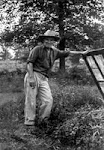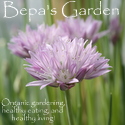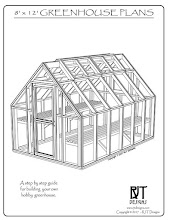Even though the gardens are just now starting to produce a bountiful harvest, it is time to start thinking about planting a fall, and winter, garden.
One of my goals is to have my gardens producing year round. I have been successful growing greens through the winter using my cold frames, but I also want to get better at succession planting and have a steady supply of certain vegetables like lettuce and carrots.
There are several great resources to help you plan a fall garden and help you can find information on what cold hardy varieties to plant and when to plant your seeds.
Johnny's Selected Seeds website will help you choose varieties to plant now and even has a Fall Planting Calculator that you can download to help you plan the correct time to plant.
Four Season Harvest and The Winter Harvest Handbook, by Eliot Coleman, are very useful books that will help you plan fall and winter gardens. These two are part of my library.
I just started reading The Year Round Vegetable Gardener, by Niki Jabbour. This book gives a lot of useful information on year round planting, growing in cold frames and using row covers and cloches to protect plants. The chapter I am reading now talks about how to determine when to start seeds so plants will be ready for harvest before your first average frost.
Here's how Niki tells you to figure it out:
You first need to know the average first frost date for your area. If you don't know this you can find it by going to the National Climate Data Center.
Next you need to look at the maturity dates for your cold hardy varieties. Niki recommends adding 1 to 2 weeks to the maturity date because the plants growth will slow as the temperatures get colder.
Average Frost Date (for my area) : October 19th
Days to maturity: (for Nutri-Bud Broccoli) - 60 days
Add 12 days for colder temps - 72 days
Now count the days back from October 19th and you end up with August 8th for the date you need to transplant your plants into the garden.
If you follow the Johnny's Fall Planting Calculator, they tell you to add another 4 weeks to plants that need to be started indoor from seed - so that would be July 11th (today!!).
Calculating seed starting dates and planting at the correct times has always been challenging for me. I created a garden journal database where I keep all my seed inventory information including maturity dates, germination dates and all of my growing information so I can easily write formulas to automatically calculate planting dates and generate a planting schedule. It is still a work in progress, but so far it has worked out well.
Hope this information helps you plan your fall and winter garden!
Our friends at 1840 Farm and Let This Mind Be In You have also written post about planting a fall garden, so be sure to check them out as well.
I am also excited to tell you that I have teamed up with both of these bloggers to participate in a giveaway for some exciting prizes so be sure to enter!
~Rob~
One of my goals is to have my gardens producing year round. I have been successful growing greens through the winter using my cold frames, but I also want to get better at succession planting and have a steady supply of certain vegetables like lettuce and carrots.
There are several great resources to help you plan a fall garden and help you can find information on what cold hardy varieties to plant and when to plant your seeds.
Johnny's Selected Seeds website will help you choose varieties to plant now and even has a Fall Planting Calculator that you can download to help you plan the correct time to plant.
Four Season Harvest and The Winter Harvest Handbook, by Eliot Coleman, are very useful books that will help you plan fall and winter gardens. These two are part of my library.
I just started reading The Year Round Vegetable Gardener, by Niki Jabbour. This book gives a lot of useful information on year round planting, growing in cold frames and using row covers and cloches to protect plants. The chapter I am reading now talks about how to determine when to start seeds so plants will be ready for harvest before your first average frost.
Here's how Niki tells you to figure it out:
You first need to know the average first frost date for your area. If you don't know this you can find it by going to the National Climate Data Center.
Next you need to look at the maturity dates for your cold hardy varieties. Niki recommends adding 1 to 2 weeks to the maturity date because the plants growth will slow as the temperatures get colder.
Average Frost Date (for my area) : October 19th
Days to maturity: (for Nutri-Bud Broccoli) - 60 days
Add 12 days for colder temps - 72 days
Now count the days back from October 19th and you end up with August 8th for the date you need to transplant your plants into the garden.
If you follow the Johnny's Fall Planting Calculator, they tell you to add another 4 weeks to plants that need to be started indoor from seed - so that would be July 11th (today!!).
Calculating seed starting dates and planting at the correct times has always been challenging for me. I created a garden journal database where I keep all my seed inventory information including maturity dates, germination dates and all of my growing information so I can easily write formulas to automatically calculate planting dates and generate a planting schedule. It is still a work in progress, but so far it has worked out well.
Hope this information helps you plan your fall and winter garden!
Our friends at 1840 Farm and Let This Mind Be In You have also written post about planting a fall garden, so be sure to check them out as well.
I am also excited to tell you that I have teamed up with both of these bloggers to participate in a giveaway for some exciting prizes so be sure to enter!
~Rob~





























